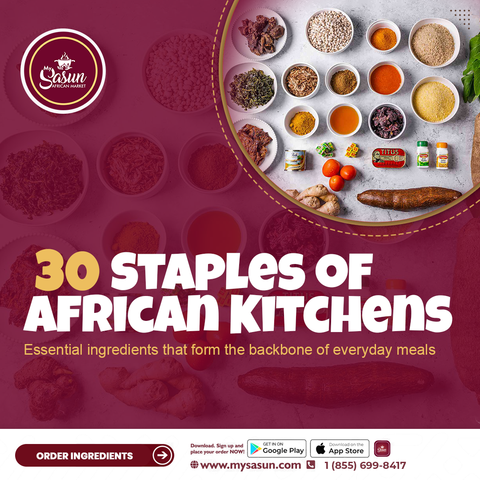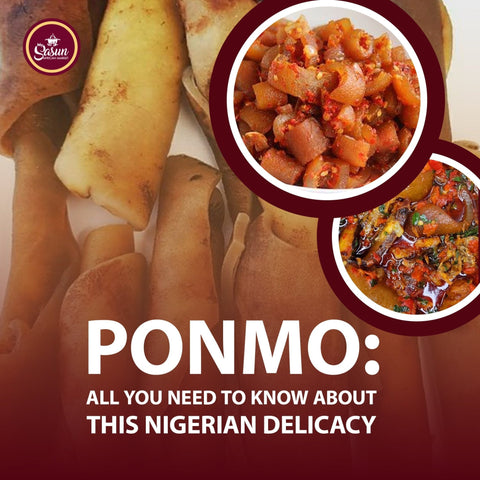When we talk about "staples" in the context of food, we're referring to those essential ingredients that form the backbone of everyday meals. They’re the foods people rely on for sustenance, eaten regularly and in large amounts. In Africa, staple foods vary significantly from region to region, thanks to the continent's vast diversity in climate, culture, and history. In this blog post, we'll take a closer look at the most popular staples across West, South, East, and North Africa, how they're stored, and how they're typically prepared and enjoyed.
Also Read: Garri Ijebu: Beyond a Staple Food
1. Cassava (Yuca)

Cassava is a critical staple in West and Central Africa. It’s used in many forms, such as garri (fermented cassava) and fufu (a starchy side dish), and is often boiled, fried, or pounded.
How It's Stored: Cassava is dried and ground into flour or chips for long-term storage.
2. Palm Oil

Palm oil is a richly coloured oil used widely in West African cuisine. It adds a deep, earthy flavour to soups like egusi and banga.
How It's Stored: Stored in jars or bottles in cool, dark spaces.
3. Maize (Corn)

Maize is a key staple across Southern and Eastern Africa, used in dishes like ugali, pap, and sadza. It’s also enjoyed roasted or boiled as a snack.
How It's Stored: Maize is dried and stored as kernels or ground into flour in sacks.
Also Read: Bobotie: The South African Delicacy You Must Try
4. Groundnut Oil (Peanut Oil)

Groundnut oil is a widely used oil in West African cooking. It’s neutral in flavour and ideal for frying and making stews like groundnut soup.
How It's Stored: Stored in bottles or containers in cool, dark places.
5. Rice

Rice is central to many African diets, especially in West and East Africa. It’s the base for iconic dishes like jollof rice and pilau.
How It's Stored: Kept in large containers or sacks in a dry, cool space.
6. Millet

Millet is an ancient grain used to make porridge, flatbreads, and even drinks in West and East Africa. It’s a resilient crop, particularly in arid regions.
How It's Stored: Stored as whole grains or ground into flour and kept dry.
Also Read: 23 LEAFY VEGETABLES IN WEST AFRICAN CUISINE
7. Plantains

Plantains are used across West and Central Africa in both sweet and starchy forms. They can be fried, boiled, or mashed, often served as a side or snack.
How They're Stored: Stored at room temperature or dried for longer use.
8. Coconut Oil

Coconut oil is a staple in East African coastal regions, used to cook seafood, curries, and stews. It adds a rich, tropical flavour to dishes.
How It's Stored: Stored in glass jars or containers, often solidifying in cooler temperatures.
9. Yams

Yams are a vital root vegetable in West Africa, commonly boiled, fried, or pounded into fufu and served with hearty soups.
How They're Stored: Stored in ventilated areas to prevent rot.
10. Okra

Okra is widely used in West and North Africa, especially as a thickener for soups and stews like okra soup and North African okra stews.
How It's Stored: Fresh okra is best, but it can also be sun-dried for extended storage.
Also Read: 9 Myths and Facts about African Foods
11. Black-eyed Peas (Cowpeas)

Black-eyed peas are a staple legume in West Africa. They’re stewed, made into fritters like akara, or steamed into moin-moin.
How They're Stored: Stored dry in airtight containers or sacks.
12. Peppers (Scotch Bonnet)

Scotch bonnet peppers are famous for their fiery heat, especially in West African dishes. They’re used in stews, soups, and sauces to bring bold, spicy flavours.
How They're Stored: Stored fresh in the fridge or dried and kept in airtight jars.
13. Sorghum

Sorghum is a drought-tolerant grain used in East and Southern Africa to make porridge, flatbread, and traditional drinks.
How It's Stored: Dried and stored in sacks or ground into flour for extended use.
14. Garlic

Garlic is used across African cuisines, particularly in North African stews and marinades. It adds aromatic depth to a variety of dishes.
How It's Stored: Stored in cool, dry spaces and can last for weeks.
Also Read: 11 Must-Try African Vegan Dishes
15. Ginger

Ginger is widely used in East African and North African cooking, bringing a zesty, spicy kick to stews, curries, and beverages like ginger tea.
How It's Stored: Fresh ginger is stored in cool places, while dried ginger is kept in airtight containers.
16. Sweet Potatoes

Sweet potatoes are a staple in East and Southern Africa, often roasted, boiled, or mashed as a side to meats or stews.
How They're Stored: Stored in cool, dry areas and can last for weeks.
17. Lentils
Lentils are common in North and East African diets. They are stewed, added to soups, or included in vegetarian dishes for a rich source of protein.
How They're Stored: Dried lentils are stored in airtight containers.
18. Couscous

Couscous is a North African staple made from semolina wheat. It’s often served with stews, tagines, and vegetables, absorbing the rich flavours of the dish.
How It's Stored: Stored dry in airtight containers.
Also Read: VARIOUS TYPES OF AFRICAN BRAIDS
19. Spinach

Spinach and other leafy greens are often stewed with onions, tomatoes, and spices in East and West Africa. They’re rich in vitamins and minerals.
How It's Stored: Fresh spinach is stored in the fridge and used within a few days.
20. Mint

Mint is particularly popular in North Africa, where it’s used in teas, salads, and tagines to provide a refreshing flavour contrast.
How It's Stored: Fresh mint can be refrigerated or dried for later use.
21. Beans

Beans, including kidney beans, butter beans, and black beans, are a key source of protein. They are used in rice dishes, stews, and soups across Africa.
How They're Stored: Dried beans are kept in sacks or jars for extended storage.
22. Thyme

Thyme is commonly used in North African and West African cooking. It adds an earthy, herbal note to stews, grilled meats, and soups.
How It's Stored: Fresh thyme can be refrigerated, while dried thyme is stored in airtight jars.
23. Teff

Teff is an Ethiopian grain used to make injera, a sour, spongy flatbread. It’s highly nutritious and gluten-free, packed with fibre and iron.
How It's Stored: Teff is stored as whole grains or ground flour in cool, dry places.
Also Read: THE PERFECT CLOTHING FOR MEMORABLE AFRICAN OCCASIONS
24. Collard Greens

Collard greens are popular in Southern and East African cooking, often stewed with onions and spices. They provide a rich source of nutrients and are a staple green in many households.
How They're Stored: Stored in the fridge and consumed within a few days.
25. Dates

Dates are widely consumed in North Africa, especially during religious fasts, where they are used in desserts and eaten as a snack. They provide a natural source of sweetness.
How They're Stored: Dates are dried and kept in airtight containers.
26. Wheat

Wheat is a staple in North African and Middle Eastern-inspired dishes. It’s used to make flatbreads like khobz and kesra, as well as being an ingredient in couscous and bulgur wheat dishes.
How It's Stored: Stored in sacks or containers as flour or grains and kept in cool, dry places.
27. Tomatoes

Tomatoes are central to African cooking, particularly in West and North Africa. They are used in everything from stews to rice dishes like jollof rice, and their rich flavour forms the base for many sauces.
How They're Stored: Fresh tomatoes are stored at room temperature, while pureed or canned tomatoes are kept in jars.
Also Read: 5 Essential Nutrients From African Foods
28. Bananas

Bananas are enjoyed across Africa, particularly in tropical regions. They are eaten fresh or added to desserts, smoothies, and even savoury dishes. In some areas, bananas are fried or boiled as part of main dishes.
How They're Stored: Stored at room temperature, bananas are best eaten when ripe.
29. Cocoyam

Cocoyam is a root vegetable similar to taro, widely used in West Africa. It’s boiled, mashed, or pounded into fufu, and is also used as a thickener in soups.
How It's Stored: Cocoyam is best stored in a cool, dry place, where it can last for several weeks.
30. Curry Powder

Curry powder is a popular spice blend in African cooking, especially in East and Southern Africa, where Indian influence is strong. This aromatic mix typically includes turmeric, cumin, coriander, ginger, and sometimes fenugreek, creating a warm, earthy flavour. It’s used in stews, curries, and rice dishes, adding a bold depth to meals.
In East Africa, curry powder is often paired with coconut milk to make rich curries featuring chicken, fish, or vegetables. In Southern Africa, it’s commonly used in bobotie (a spiced meat dish) and flavourful sauces.
How it’s stored: Keep curry powder in an airtight container in a cool, dry place to preserve its potency.
Also Read: HOW TO MAKE THE BEST AFRICAN GROUNDNUT SOUP
Frequently Asked Questions (FAQs)
-
What are the most popular staple foods in Africa?
Staples like maize, cassava, rice, and millet are widely consumed across Africa. Other staples include plantains, yams, and beans, which vary by region.
-
How are staple foods stored in African kitchens?
Staple foods like grains (maize, millet, sorghum) and legumes (beans, lentils) are typically dried and stored in sacks or airtight containers. This method helps keep moisture out and prevents spoilage. Root vegetables like cassava and yams are stored in cool, ventilated spaces to maintain freshness. Oils like palm oil and groundnut oil are stored in glass or plastic containers in cool, dark places to extend their shelf life.
-
What oils are most commonly used in African cuisine?
The three main oils used across Africa are:
- Palm Oil: Common in West Africa, this oil adds a distinct red colour and rich, earthy flavour to soups and stews.
- Groundnut (Peanut) Oil: Widely used in West and East Africa for frying and sautéing.
- Coconut Oil: Used primarily in East Africa, especially along coastal areas, for making curries and seafood dishes.
Also Read: The Surprising Benefits of Eating More African Foods in the Diaspora
-
What is the role of spices in African cooking?
Spices are essential in African cooking, bringing depth and complexity to dishes. Commonly used spices include cumin, paprika, ginger, and coriander. North African dishes often use spice blends like ras el hanout, while West African cuisine relies on hot peppers and ginger. East African dishes are heavily influenced by Indian spices like curry powder, cloves, and cinnamon, creating a warm, aromatic profile.
-
How is curry powder used in African cuisine?
Curry powder is a spice blend commonly used in East African and Southern African cooking, particularly in countries with Indian influences like Kenya, Tanzania, and South Africa. This fragrant spice mix typically contains turmeric, cumin, coriander, ginger, and fenugreek, though the exact blend varies by region. It is used to season stews, curries, and even rice dishes, adding a warm, aromatic depth to meals. In East Africa, it’s often paired with coconut milk to create rich, flavourful curries featuring chicken, fish, or vegetables.
How It's Stored: Curry powder is stored in airtight containers and kept in a cool, dry place to preserve its freshness and potency.
-
What are the most commonly used vegetables in African cooking?
Common vegetables in African kitchens include okra, spinach, collard greens, eggplant, tomatoes, and sweet potatoes. These vegetables are used in a variety of ways—stewed, roasted, or sautéed with onions, tomatoes, and spices. Leafy greens are especially popular, offering a nutritious component to many meals.
-
How do African cuisines differ by region?
African cuisines vary significantly by region:
- West Africa: Known for dishes like jollof rice and egusi soup, with staples like cassava, yams, and plantains. Palm oil and hot peppers dominate the flavour profile.
- East Africa: Features Indian-inspired dishes with curry powder, coconut milk, and spices like cardamom and cloves. Staples include maize (ugali) and rice dishes like pilau.
- North Africa: Dishes like couscous, tagines, and flatbreads are flavoured with spices like cumin, coriander, and saffron.
- Southern Africa: Maize-based dishes like pap or sadza are often served with grilled meats or hearty vegetable stews.
Also Read: How to lower your blood pressure with African herbs and spices
Rounding Off:
These staples of African kitchens tell a vibrant, flavourful story of Africa's rich agricultural diversity and deep-rooted cultural heritage. Each ingredient brings a unique character to the table- the heat of spices, the heartiness of the grains, the richness of oils. At My Sasun African Market, you’ll find all these essentials, ready to help you recreate authentic African dishes and bring the taste of the continent into your kitchen. Embrace the flavours of Africa and experience the comfort of home-cooked, traditional meals toda. Start shopping!
Also Read: Top Three African Markets/Grocery Stores in the US








Comments (5)
I am Dr. Ayo Christopher, I am a Great traditional Herbal Medicine Doctor. I specialize in treating any kind of diseases and infections using natural Herbal Medicine. I have effective Herbal Cure for Herpes, scabiei mite, Diabetes, Virginal infection, Genital, Gonorrhea, warts virus infections, Leukemia, Lung Cancer, Menopause, Hepatitis A B C and HIV and other deadly infections. I have treated more than 20 patients that have Herpes (HSV 2) and all of them were cured. My herbal medicine is 100% safe, there are no side effects and You will start seeing clear results as early as 7 days.
If you have been taking conventional medicines for that Herpes infection and you are still having those re-occurring outbreaks, why don’t you try Herbal Medicines and see it get cured in weeks. For more information, send me anEmail: ridvid8@gmail.com
Telegram: @wafri01
website: //ridvid8.wixsite.com/dr-ayo-herbs-home/about-5
I was diagnosed of HERPES Virus in 2020 and I have tried all I can to get cured but all to no avail, until i saw a post in a health forum about a herbalist man who prepare herbal medication to cure all kind of diseases including HERPES virus, at first i doubted if it was real but decided to give it a try , when i contact this herbalist and he prepared a HERPES herbal cure and sent it to me via FEDEX delivery company service, when i received this herbal cure, he gave me step by directions on how to apply it, when i applied it as instructed, i was totally cured of this horrible disease within 14days of usage, i went to the hospital for a test and it was negative. I can tell the public now that I am now free from the horrible disease called herpes, all thanks to Dr.Kano that is why I want to leave his email address and What’s app contact just if you want to contact him for help. He also have cure for Alzheimer virus, Cancer, HIV, Genital warts, ALS, BV, UTI, Virginal infection, HPV, Hepatitis A/B, Fibroid.
you can reach this great herbal doctor via his email on (drkanopureherbalhome@gmail.com) whatsapp (+2348164749895)
My purpose out here today is to share this article to the world about how Doctor Odunga helped me in getting back my EX-boyfriend who broke up with me 4 months ago. I tried all I could to make him see reasons with me so that we can continue our relationship but he denied me. Thank God for giving me the thought of going into the internet for help, I searched properly and I saw different reviews of Doctor Odunga and I insisted on giving it a try by contacting him via what’s app on (+2348167159012). He gave me reason to live again and he prepared a spell and told me that my Ex-boyfriend will come back to me within 11 hours. Can you believe it, my EX-boyfriend came back to me, proposed to me and our wedding will be held soon. Contact him now!!! if you need any help. Email: odungaspelltemple@gmail.com and he does a lot of spells. Once again i want to say am very grateful for your help
Am really grateful and thankful for what Dr Ahonsie has done for me and my family. I Was having HERPES for good three years with no solution, the diseases almost took my life and because I was unable to work and I was also loosing lots of money .for medication, but one faithful day when I went online, I met lots of testimonies about this great man so I decided to give it a try and to God be the glory he did it. he cured me of my diseases and am so happy and so pleased to Write about him today. if you need his help or you also want to get cured just the way I got mine, just email him below drahonsie002@gmail.com You can also call or whatsApp his telephone number on +2348039482367. https://drahonsie002.wixsite.com/dr-ahonsie https://www.facebook.com/drstellaherbalhome?mibextid=ZbWKwLThanks once again Dr Ahonsie.
My heart is so filled with joy. If you are suffering from Erectile dysfunction or any other disease you can contact Dr. Moses Buba on this buba.herbalmiraclemedicine@gmail.com or His website : https://www.facebook.com/profile.php?id=61559577240930 . For more information from me reach me via WhatsApp : +44 7375 301397